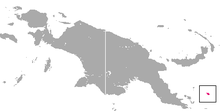Woodlark couscous
| Woodlark couscous | ||||||||||||
|---|---|---|---|---|---|---|---|---|---|---|---|---|
| Systematics | ||||||||||||
|
||||||||||||
| Scientific name | ||||||||||||
| Phalanger lullulae | ||||||||||||
| Thomas , 1895 |
The Woodlark couscous ( Phalanger lullulae ) is a marsupial from the climbing family (Phalangeridae), which occurs on the islands of Woodlark and Madau and on the Alcester Islands east of New Guinea. The species may first have been introduced by humans on the Alcester Islands.
features
The Woodlark cuscus is a medium-sized cuscus species and reaches a body length of 33 to 41 cm, has a 27.5 to 34.5 cm long prehensile tail and weighs 1.5 to 2 kg. The coloration of the Woodlark cuscus is very variable. The fur on the back is usually irregularly brown, ginger-colored and whitish, the peritoneum is whitish with dark spots. Some specimens are more dark brown with light spots, others are mainly ginger in color with a few whitish and dark spots. A dark median runs from the head to the shoulders. The nasal mirror is pink. The skull of the Woodlark cuscus is similar to that of the Moluccan cuscus , but does not show a diastema between the incisors and the canines.
Habitat and way of life
The Woodlark cuscus is found in primary and secondary forests and is more common on Woodlark in the dry, eastern lowlands than in the dense forests of the west of the island. Like all couscous, it feeds primarily on leaves and fruits. According to the islanders, he prefers the shrub Melanococca tomentosa , which grows mainly in overgrown gardens. They also consume nectar from climbing plants. Little is known about behavior and reproduction. The animals communicate with each other with different sounds that sound like barking, growling or the crying of human babies. Many of these sounds are emitted while searching for food. The Woodlark cuscus is nocturnal and spends the day in tree hollows or under dense stands of epiphytes . He leaves this shortly after sunset. The reproductive phase is apparently relatively long and takes several months.
Danger
The IUCN estimates the stock of Woodlark couscous as endangered ( Endangered on). Its distribution area is relatively small and a Malay company is planning to clear most of the original forest on Woodlark in order to sell the wood and then plant oil palm plantations.
supporting documents
- ↑ a b c d Kristofer Helgen & Stephen Jackson: Family Phalangeridae (Cuscuses, Brush-tailed Possums and Scaly-tailed Possum). In: Don E. Wilson , Russell A. Mittermeier : Handbook of the Mammals of the World - Volume 5. Monotremes and Marsupials. Lynx Editions, 2015, ISBN 978-84-96553-99-6 , p. 490.
- ↑ Woodlark Kuskus threatened. Stop the deforestation! Rettet den Regenwald eV Accessed May 12, 2015

